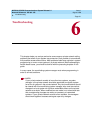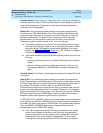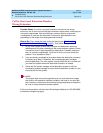
MERLIN LEGEND Communications System Release 6.1
Network Reference
555-661-150
Issue 1
August 1998
Troubleshooting
Page 6-7Call to Non-Local Extension: Silence or Fast Busy Tone
6
than routes that specify tandem facilities, you may need to adjust extension
and route FRLs in order to restrict access to them. Be sure that you discuss
any changes with the coordinating system manager.
■ If the routing is correct and enough routes are included in the pattern, but
the problem persists, check if PRI lines are used. If they are, check the
error log for D-channel inoperative and loss of signal alarms indicating lines
are inoperative. If the D-channel inoperative alarm has occurred, check the
CSU/DSU associated with the line for correct programming. If the loss at
signal alarm has occurred, check for open cables, etc. If these conditions
are not present, go to Possible Cause 3.
Possible Cause 2: Callback Queuing is not used.
What to Do: All available local routes for the call may be busy, and Automatic or
Selective Callback allows the call to queue for the next available tandem trunk
assigned to the Route 1 pool. As a first step, the caller should try using Callback.
If a user is having trouble with the Callback feature, see “Callback Does Not Work”
on page 20.
Possible Cause 3: Not enough trunks are assigned to the pools for UDP routes.
What to Do: To verify, check the error log for pool busy errors (such as 4c02, Pool
Busy). Consult System Form 2c, System Numbering: Line/Trunk Jacks to
determine the assignments. To see a report of pool assignments, select the
3ULQW
option on the System Programming menu and then choose
7UXQN,QIRand
*HQHUDO
.
■ If more trunks are available and need to be assigned, follow the procedure
in “Trunks to Pools Assignment” in Chapter 4 of
System Programming
to
assign more tandem trunks. All the tandem trunks in a pool must be of the
same type (tie or PRI).
■ If not enough trunks are available, consider adding more to your system.
■ If there are sufficient trunks assigned but the problem persists, go to
Possible Cause 4.
Possible Cause 4: Facilities are available but restricted and the caller is not able
to access them.
What to Do: Verify that the extension’s FRL is higher than or equal to the UDP
route FRL.
If you want to make changes in FRLs for routes, speak with the coordinating
system manager for your private network and consult the following resources:
■ “How Facility Restrictions Levels Work in a Network” on page 9 discusses
FRL planning in detail.
■ To change a UDP route FRL, see “Uniform Dial Plan Routing” on page 25
or “UDP Routing” in Chapter 4 of
System Programming.


















